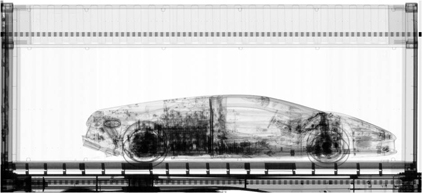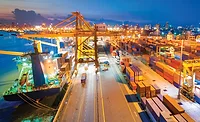Why Global Supply Chains Need Global Shared Security Standards

|
| A screening of a shipping container reveals its cargo, but not all countries require standardized screening on shipments, leaving gaps in international security. Photo courtesy of Rapiscan |
The attempted bombing of two cargo aircraft in October 2010 via hidden explosives inside printer cartridges illuminated one thing to the air cargo industry – it is not immune to terrorism. Even though the ultimate target of these bombs were locations in the United States, the dispersed nature of this specific threat, with the initial bombs originating in Yemen and the compromised packages discovered in Saudi Arabia and England, it hammered home the point that terrorism is a global security challenge and one that every country must be prepared to combat.
The sheer amount of regulatory activity since 2010 is evidence as this, with various laws and initiatives launched to keep cargo, passenger planes and supply chains secure. In addition to the U.S. Transportation Security Administration’s (TSA) requirement that 100 percent of cargo packages loaded onto passenger aircraft be screened, the agency has also rolled out the Air Cargo Advance Screening (ACAS) pilot program in conjunction with U.S. Customs and Border Protection (CBP).
Intended to enhance air cargo supply chain security, ACAS targets air cargo shipments bound for the U.S. from foreign locations. Through cutting-edge technology, ACAS allows the TSA and CBP to gather advance security data on inbound cargo shipments, identifying high-risk shipments and tagging them for additional screening well before they reach U.S. soil.
The United States, however, is not the only nation seeking to keep its populace and infrastructure secure; across the globe, every country is after the same goal. Nor is the United States unique in developing stringent security standards for inbound goods and cargo. Similar regulations exist from the EU to Russia to China to the Middle East, but the key word is “similar.”
While the U.S. and EU have gone so far as to recognize each other’s cargo security programs – which will reduce redundancies, allocate screening resources more effectively and allow cargo screening operations to run more efficiently – lacking still is synchronized global security regulation. ACAS is a step in the right direction but without a deeper harmonization of international security screening standards, airlines, freight forwarders and express carriers need to have a different security plan for each country they fly out of – which for some could mean hundreds of different security plans.
Further complicating the issue is the fact that several of the fastest growing countries in the world are the furthest back in aviation and cargo security standards. While some of these countries may adopt screening regulations provided by the World Customs Organization (WCO) or the International Civil Aviation Organization (ICAO), there is no integration between ACAS and what the WCO and ICAO require of shippers.
The lack of harmonized standards has the potential to compromise even the most stringent security plans and could end up being very costly to international airlines and cargo carriers. While many governments and industry experts support the obvious benefits of harmonized standards, it is perhaps the lesser known benefits that make the most ardent case for the need to adopt shared regulations.
More standardization makes it easier for security officials, airlines and freight forwarders to take advantage of emerging security technologies. ACAS is a great example of one such approach, but in order to be truly effective, the program, or a similar plan, must be adopted on a global scale. Synchronizing the data that counterterrorist and homeland security agencies around the world need to detect and neutralize cargo-borne threats greatly improves their ability to fight the global war against terrorism.
Harmonized standards also expand the global market for manufacturers of security scanning systems, but this doesn’t just mean more profits for vendors. The more certainty that software and security companies have about scanning requirements on a global level, the bigger the market becomes and increases technological competition and innovation. As they no longer need to design systems for each and every country, security equipment manufacturers can boost research and develop, doing more than just keeping pace with cargo-borne threats but staying one-to-several steps ahead.
While there is movement towards harmonized security screening standards, and much of the groundwork has been laid, there is still much to be done to see this to fruition. At a global level, governments must understand that when it comes to security, uniting behind a common goal is always better than standing separate behind a single banner.
Looking for a reprint of this article?
From high-res PDFs to custom plaques, order your copy today!




